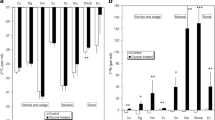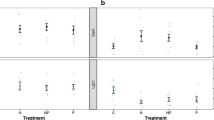Abstract
Over half of the world's peat originated from Sphagnum, representing 10–15% of the terrestrial carbon stock. However, information regarding the release and exudation of organic carbon by living Sphagnum plants into the surface peat is scarce. In this study, we examined the contribution of recent Sphagnum subnitens (Russ. and Warnst.) photosynthate carbon to the peatland dissolved organic carbon (DOC) pool. This was done using a 13CO2 pulse-chase experimental approach during the growing season. Despite the importance of Sphagnum in long-term carbon accumulation, results showed that the Sphagnum community rapidly contributes recently synthesized carbon to the peatland DOC pool. We estimate that by 4 h up to 4% of the total DOC in peat leachate was derived from 13CO2 pulse labelling at ambient CO2 concentrations. Nonetheless, a huge 64% of the 13C initially assimilated by photosynthesis was retained in Sphagnum subnitens for 23 days after labelling, consistent with the role of Sphagnum in peatland carbon accumulation. The majority of 13C loss as respired CO2 came within the few days post 13CO2 labelling, suggesting that it was derived from plant respiration of photosynthates.
Similar content being viewed by others
References
Andrus R 1986 Some aspects of Sphagnum ecology. Can. J. Bot. 64, 416–426.
Balesdent J and Balabane M 1996 Major contribution of roots to soil carbon storage inferred from maize cultivated soils. Soil Biol. Biochem. 28, 1261–1263.
Brock T D 1966. Fundamentals of Microbial Ecology. Prentice Hall, Englewood Cliffs, 306 pp.
Charman D J, Aravena R, and Warner B G 1994 Carbon dynamics in a forested peatland in north-eastern Ontario, Canada. J. Ecol. 82, 55–62.
Charman D J, Aravena R, Bryant C L and Harkness D D 1999 Carbon isotopes in peat, DOC, CO2, and CH4 in a holocene peatland on Dartmoor, southwest England. Geology 27, 539–542.
Chasar L S, Chanton J P, Glaser P H, Siegel D I and Rivers J S 2000 Radiocarbon and stable carbon isotopic evidence for transport and transformation of dissolved organic carbon, dissolved inorganic carbon, and CH4 in a northern Minnesota peatland. Glob. Biogeochem. Cycles 14, 1095–1108.
Clymo R S 1983 Peat. In Mires: Swamp, Bog, Fen and Moor. Ecosystems of the world 4A. Ed. A J P Gore. pp. 159–224. Elsevier, Amsterdam.
Clymo R S and Hayward P M 1982 The ecology of Sphagnum. In Bryophyte Ecology. Ed. A J E Smith. pp. 229–289. Chapman and Hall, New York
Cocksedge J L 1988 Design and production of synthetic rainwater. LR 684 (CS). Department of Trade and Industry. Warren Spring Laboratory. HMSO 58155.
Evans C D, Freeman C, Monteith D T, Reynolds B and Fenner N 2002 Terrestrial export of organic carbon. Nature 415, 862.
Fenner N, Freeman C, Hughes S and Reynolds B 2001 Molecular weight spectra of dissolved organic carbon in a rewetted Welsh peatland and possible implications for water quality. Soil Use Manag. 17, 106–112.
Freeman C, Lock M A and Reynolds B 1993a Impacts of climatic change on peatland hydrochemistry; a laboratory based experiment. Chem. Ecol. 8, 49–59.
Freeman C, Hawkins J, Lock M A and Reynolds B 1993b A laboratory perfusion system for the study of biogeochemical responses of wetlands to climate change. In Wetlands and Ecotones: Studies on land-water interactions. Eds. B Gopal, A Hillbricht-Ilkowska and R G Wetzel. National Institute of Ecology, New Delhi.
Freeman C, Ostle N and Kang H 2001a An enzymic ‘latch’ on a global carbon store. Nature 409, 149.
Freeman C, Evans C D, Monteith D T, Reynolds B and Fenner N 2001b Export of organic carbon from peat soils. Nature 412, 785.
Gajewski K, Viau A, Sawada M, Atkinson D and Wilson S 2001 Sphagnum peatland distribution in North America and Eurasia during the past 21,000 years. Glob. Biogeochem. Cycles 15, 297–310.
Gorham E 1991 Northern peatlands: Role in the carbon cycle and probable responses to climatic warming. Ecol. Appl. 1, 185–192.
Hamilton E W and Frank D A 2001 Can plants stimulate soil microbes and their own nutrient supply? Evidence from a grazing tolerant grass. Ecology 82, 2397–2402.
Hartmann M 1999 Species dependent root decomposition in rewetted fen soils. Plant Soil 213, 93–98.
Hope D, Billet M F and Cresser M S 1994 A review of the export of carbon in river water: fluxes and processes. Environ. Pollut. 84, 301–324.
Hope D, Billet M F, Milne R and Brown T W 1997 Exports of organic carbon in British rivers. Hydrol. Process. 11, 325–324.
Ineson P, Cotrufo M F, Bol R, Harkness D D and Blum H 1996 Quantification of soil carbon inputs under elevated CO2: C-3 plants in a C-4 soil. Plant Soil 187, 345–350.
King J Y, Reeburgh W S, Thieler K K, Kling G W, Loya W M, Johnson L C and Nadelhoffer K J 2002 Pulse-labeling studies of carbon cycling in Arctic tundra ecosystems: The contribution of photosynthates to methane emission. Glob. Biogeochem. Cycles 16, 1062.
Kuzyakov Y 2002 Separating microbial respiration of exudates from root respiration in non-sterile soils: a comparison of four methods. Soil Biol. Biochem. 34, 1621–1631.
Loya W M, Johnson L C, Kling G W, King J Y, Reeburgh W S and and Nadelhoffer K J 2002 Pulse-labeling studies of carbon cycling in arctic tundra ecosystems: Contribution of photosynthates to soil organic matter. Glob. Biogeochem. Cycles 16, 1101.
Lynch J M and Whipps J M 1990 Substrate flow in the rhizosphere. Plant Soil 129, 1–10.
Megonigal J P, Whalen S C, Tissue D T, Bovard B D, Albert D B and Allen A S 1999 A plant-soil-atmosphere microcosm for tracing radio-carbon from photosynthesis through methanogenesis. Soil Sci. Soc. Am. J. 63, 665–671
Mikkela C, Sundh I, Svensson B H and Nilsson M 1995 Diurnal-variation in methane emission in relation to the water-table, soil-temperature, climate and vegetation cover in a Swedish acid mire. Biogeochemistry 28, 93–114.
Mill A J B 1976 Geochemical studies on colloidal and molecular constituents in surface waters. Colloid Science and Technology. 269 p.
Ohlson M and Okland R H 1998 Spatial variation in rates of carbon and nitrogen accumulation in a boreal bog. Ecology 79, 2745–2758.
Ostle N, Ineson P, Benham D and Sleep D 2000 Carbon assimilation and turnover in grassland vegetation using an in situ 13CO2 pulse labelling system. Rapid Commun. Mass Spectrom. 14, 1345–1350.
Painter T J 1983 Residues of D-lyxo-5-hexosulopyranuronic acid in Sphagnum holocellulose, and their role in cross-linking. Carbohydr. Res. 124, C18–C21.
Palmer S M, Hope D, Billet M F, Dawson J J C and Bryant C L 2001 Sources of organic and inorganic carbon in a headwater stream: Evidence from carbon isotope studies. Biogeochemistry 52, 321–338.
Palta J A and Gregory P J 1997 Drought affects the fluxes of carbon to roots and soil in C-13 pulse-labelled plants of wheat. Soil Biol. Biochem. 29, 1395–1403.
Paterson E, Hall J M, Rattray E A S, Griffiths B S, Ritz K and Killham K 1997 Effect of elevated CO2 on rhizosphere carbon flow and soil microbial processes. Glob. Change Biol. 3, 363–377.
Rasmussen S, Wolff C and Rudolph H 1995 Compartmentalization of phenolic constituents in Sphagnum. Phytochemistry 38, 35–39.
Scheffer R A and Aerts R 2000 Root decomposition and soil nutrient and carbon cycling in two temperate fen ecosystems. Oikos 91, 541–549.
Schiff S, Aravena R, Mewhinney E, Elgood R, Warner B, Dillon P and Trumbore S 1998 Precambrian shield wetlands: Hydrologic control of the sources and export of dissolved organic matter. Clim. Change 40, 167–188.
Steel R G D and Torrie J H 1980 Principles and Procedures of Statistics: A Biometrical Approach. McGraw-Hill Kogakusha, Tokyo.
Thormann M N, Bayley S E and Randolph S C 2001 Comparison of decomposition of belowground and aboveground plant litters in peatlands of boreal Alberta, Canada. Can. J. Bot. 79, 9–22.
Thurman E N 1985 Organic Chemistry of Natural Waters. Nijhoff/Junk, Dordrecht.
Tolonen K and Turunen J 1996 Accumulation rates of carbon in mires in Finland and implications for climate change. Holocene 6, 171–178.
Turetsky M R and Wieder R K 1999 Boreal bog Sphagnum refixes soil produced and respired CO2-C-14. Ecoscience 6, 587–591.
Verhoeven J T A and Toth E 1995 Decomposition of Carex and Sphagnum litter in fens: Effect of litter quality and inhibition of living tissue homogenates. Soil Biol. Biochem. 27, 271–275.
Wetzel R G 1992 Gradient dominated ecosystems: sources and regulatory functions of dissolved organic matter in freshwater ecosystems. Hydrobiologia 229, 181–198.
Author information
Authors and Affiliations
Rights and permissions
About this article
Cite this article
Fenner, N., Ostle, N., Freeman, C. et al. Peatland carbon efflux partitioning reveals that Sphagnum photosynthate contributes to the DOC pool. Plant and Soil 259, 345–354 (2004). https://doi.org/10.1023/B:PLSO.0000020981.90823.c1
Issue Date:
DOI: https://doi.org/10.1023/B:PLSO.0000020981.90823.c1




